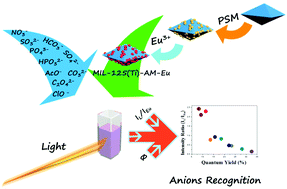A postsynthetically modified MOF hybrid as a ratiometric fluorescent sensor for anion recognition and detection†
Abstract
A metal–organic framework (MOF), MIL-125(Ti)-NH2, and its derivatives MIL-125(Ti)-AM and MIL-125(Ti)-AM-Eu are synthesized. The structure and morphology of the obtained-samples are characterized by some characterization methods such as XRD, SEM, IR and XPS. Under solvothermal conditions, MIL-125(Ti)-NH2 shows typical truncated bipyramid morphology, and the terminal amino group can be further modified by covalent postsynthetic modification (PSM). The functional MOFs exhibit excellent photoluminescence features, and they have been designed to be a ratiometric fluorescent sensor (IL/IEu) for sensitively detecting phosphate and oxalate, which are important substances in an organism. In our research, we also investigate the lifetime and quantum yield of MIL-125(Ti)-AM-Eu, and analyze the changes of that which are caused by various anions. Finally, we utilize the luminescence ratio (IL/IEu) and the quantum yield to establish an orthogonal pattern for anion recognition. MIL-125(Ti)-AM-Eu can be used to detect some unknown anions, and we find that the detector has high sensitivity and stability, and can be used repeatedly.


 Please wait while we load your content...
Please wait while we load your content...